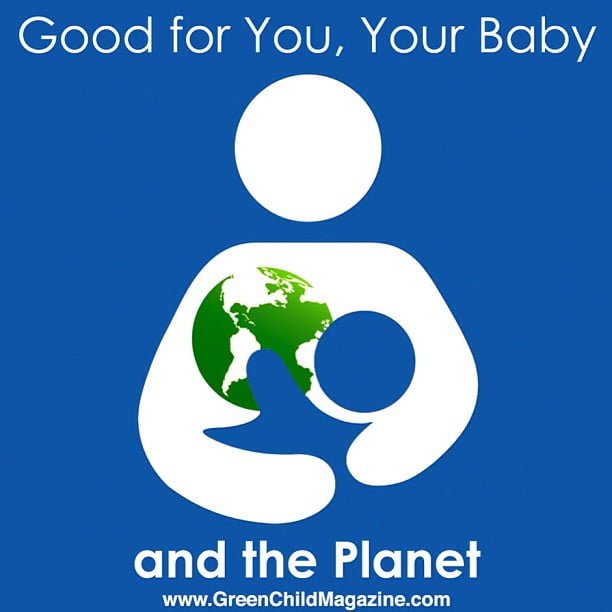Breastfeeding is Good for the Environment, Baby, and You
Much attention is given to the countless pros of breastfeeding for baby and mother. But have you ever considered the environmental benefits of breastfeeding?

Human milk has everything a baby’s body needs—a perfect blend of calories, nutrients, and antibodies. Breastfeeding also provides benefits to the mother, including reduced rates of breast and ovarian cancer later in life.
The Environmental Benefits of Breastfeeding
Besides protecting the health of mothers and babies (and being free!), breastfeeding has an inherent way of protecting the health of our planet as a whole.
We’re taking a look at the environmental benefits of breastfeeding by highlighting just a few of the important ways it helps Mother Earth. These points are by no means an attempt to shame families who choose formula.
Eco-Friendly Packaging
Breast milk comes in the most eco-friendly packaging imaginable. By contrast, the packaging and production of infant formula consumes resources and contributes to our growing landfills.
If every baby in the US were fed infant formula from birth, the packaging alone would require more than 100,000 tons of metal and nearly 1,500 tons of paper. The manufacturing of plastic feeding bottles also consumes significant petroleum, and it takes hundreds of years for these bottles to break down in landfills.
No Greenhouse Emissions
Livestock is responsible for more than 20% of greenhouse emissions. Cows produce considerable methane, nitrous oxide, and carbon dioxide, making infant formula one of the more emissions-intensive foods.
Breast milk is produced efficiently through a mother’s fat stores, making it a carbon-neutral food source.
Energy and Land Conservation
Every dairy cow producing milk for infant formula requires about one hectare of land, in addition to the land needed to produce cattle feed. Dairy farming contributes to land and water pollution, deforestation as well as soil erosion.
Some infant formula is made from soybeans, which require significant pesticides and chemicals for fertilization. Soy farming is also a contributor to deforestation of the Amazon rainforest. (source)
When it comes to energy use, milk straight from the breast comes out at exactly the right temperature. Formula typically requires energy and water for proper heating, preparation, and sterilization of bottles. (Pumped and heated breast milk also requires heating and sterilization.)
Zero “Food Miles”
Breastfeeding requires zero transportation or factory processing, making it the ultimate in eating local.
Infant formula requires shipments to multiple factories for processing, packaging and distribution thousands of miles away. The entire manufacturing and distribution process consumes significant fuel and energy.

Reduced Chemical and Toxin Exposure
While there have been a few recent headlines about environmental contaminants detected in breast milk, research shows that the risks of not breastfeeding outweigh the concerns.
“No environmental contaminant, except in situations of acute poisoning, has been found to cause more harm to infants than does lack of breastfeeding,” explains Miriam Labbok, MD, MPH, IBCLC.
There is a greater risk of contamination of infant formula, which has been subject to numerous recalls over the last decade. Formula packaging and bottles can also contain chemicals like bisphenol-A (BPA) that can leach into milk and harm the environment.
Breastfed children are less likely to require prescription drugs throughout their lifetime, keeping dangerous chemical compounds out of our landfills and drinking water. That’s definitely a reason breastfeeding is better for the environment and longterm health.
Environmental Impact Differences in Emergencies
An Australian doctor, Karleen Gribble, has written a report on infant feeding in emergencies. An emergency preparedness kit for formula-fed infants is recommended to include:
- two 900g tins of powdered infant formula
- 170 liters of drinking water
- a storage container
- large cooking pot with lid
- kettle
- gas stove
- box of matches
- liquid petroleum gas
- measuring container
- metal knife
- metal tongs
- feeding cup/bottles and nipples/paper towels and detergent
- 100 diapers and 200 wipes (source)
A breastfeeding mother needs no equipment to feed her baby and her only baby-related extra cost during an emergency would be for diapers and wipes.
With increasing societal awareness of the importance of conservation, it’s surprising that the environmental benefits of breastfeeding don’t get more attention.
As advocates of greener living and protecting the environment, supporting breastfeeding is one of the simplest ways we can contribute to a healthier planet and society.

nice article! breast milk is indeed a very important thing that can affect a baby’s growth. this is usually often overlooked, due to lack of knowledge about the importance of breast milk. this article helps many people, including me, find out the importance of breast milk for the growth of a baby. thanks for sharing!